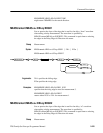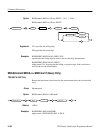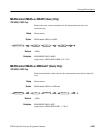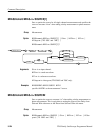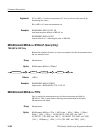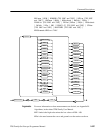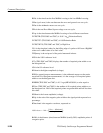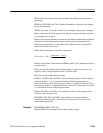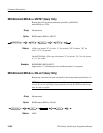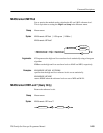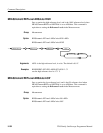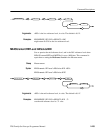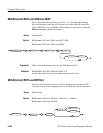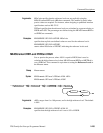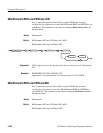
Command Descriptions
TDS Family Oscilloscope Programmer Manual
2–229
PDUty is the ratio of the positive pulse width to the signal period expressed as a
percentage.
PEAKHits (TDS 500C and 700C) displays the number of points in the largest
bin of the histogram.
PERIod is the time, in seconds, it takes for one complete signal cycle to happen.
PHAse is the amount of shift, expressed in degrees, from the selected waveform
to the designated waveform.
PK2pk is the absolute difference between the maximum and minimum amplitude.
It can be used with both general purpose and histogram measurements. For
histogram measurements, it is the value of the highest nonzero bin minus the
value of the lowest nonzero bin.
POVershoot is the positive overshoot, expressed as:
POVershoot + 100
ǒ
(Maximum * High)
Amplitude
Ǔ
PWIdth is the distance (time) between MidRef (usually 50%) amplitude points of
a positive pulse.
RISe is the time that it takes for the leading edge of a pulse to rise from a low
reference value to a high reference value of its final value.
RMS is the true Root Mean Square voltage.
SIGMA[1-3] (TDS 500C and 700C) is the percentage of points in the histogram
which are within 1, 2, or 3 standard deviations of the histogram mean. In a
normal distribution, 66% of the points are within +–1 standard deviation, 95% of
the points are within +–2 standard deviations, and 97.5% of the points are within
+–3 standard deviations of the histogram mean.
STDdev (TDS 500C and 700C) is the standard deviation of all acquired points
within or on the histogram box.
WAVEFORMS (TDS 500C and 700C) is the number of waveforms that have
contributed to the histogram. A waveform is counted even if no points were
within the histogram box.
MEASUREMENT:MEAS3:TYPE RMS
specifies MEAS3 to calculate the Root Mean Square voltage.
Examples



